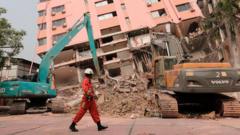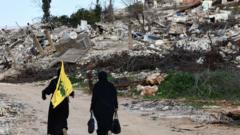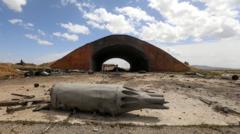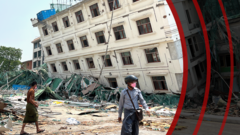The emergence of significant chemical weapons threats in Syria presents a critical challenge for the new government as fears mount over the potential dangers of these weapons being left unchecked.
**Chemical Weapons Threat Looms in Post-Assad Syria**

**Chemical Weapons Threat Looms in Post-Assad Syria**
Experts Warn of Over 100 Unsecured Chemical Sites Following Regime Change
In the wake of Bashar al-Assad’s regime collapse, an alarming assessment reveals more than 100 potential chemical weapons sites scattered throughout Syria. This first-of-its-kind estimate comes from the Organization for the Prohibition of Chemical Weapons (OPCW), which is now seeking to access these locations to determine the status of Assad’s notorious chemical arsenal. The extensive cache exceeds any figures previously acknowledged by the former dictator.
Through the years of the devastating civil war, chemical agents—including sarin and chlorine gas—were notoriously deployed by Assad against both insurgent forces and civilians alike, leaving a painful legacy of destruction. The number and security status of these sites remained unknown following the regime change last year, thus representing a major concern for the nation’s new caretaker government led by Hayat Tahrir al-Sham, a group recognized as a terrorist organization by the U.S., despite its claims of distancing from Al Qaeda.
The implications of these chemical stockpiles are dire, especially for populous urban centers. Sarin, a potent nerve agent, can induce rapid fatalities, while chlorine and mustard gas, infamous since World War I, inflict severe injuries, causing insufferable burning sensations and asphyxiation. The urgency to address this dangerous remnant of war cannot be overstated, and the new administration faces a formidable test in securing these hazardous materials before they can be exploited or result in further calamities.
Through the years of the devastating civil war, chemical agents—including sarin and chlorine gas—were notoriously deployed by Assad against both insurgent forces and civilians alike, leaving a painful legacy of destruction. The number and security status of these sites remained unknown following the regime change last year, thus representing a major concern for the nation’s new caretaker government led by Hayat Tahrir al-Sham, a group recognized as a terrorist organization by the U.S., despite its claims of distancing from Al Qaeda.
The implications of these chemical stockpiles are dire, especially for populous urban centers. Sarin, a potent nerve agent, can induce rapid fatalities, while chlorine and mustard gas, infamous since World War I, inflict severe injuries, causing insufferable burning sensations and asphyxiation. The urgency to address this dangerous remnant of war cannot be overstated, and the new administration faces a formidable test in securing these hazardous materials before they can be exploited or result in further calamities.


















